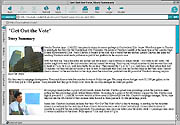|
| |
|
Definition Anchored instruction lies within the social constructivist paradigm since small groups work together to understand and solve realistic problems. Anchored instruction is most closely related to the goal-based scenario model. While anchored instruction may also resemble problem-based learning (PBL), it is less open-ended. Most anchored modules are designed for young learners, and thus embed all of the necessary data to solve the problem within the modules themselves. Substantial independent research and data collection are not required in anchored modules, but are required in PBL. Download annotated Powerpoint slides describing the anchored instruction model (PDF File). |
 |
Relevant Examples If you have created course materials at Virginia Tech that are representative of this teaching model, we would like to showcase your work here. Please contact us with a description of your project so other faculty may learn from your efforts. |
|
Design and Development Tips Glaser and Prestidge (1995) suggest technologies useful for
delivering anchored modules will include affordances for students to
segment and chunk data from the presented "stories" or problems.
Videodiscs, for example, include various time codes or markers for
different video segments. Students can easily write down a time code
corresponding to a clue in the story line, then refer back to that
information when needed. Since all data required to solve a problem should
be embedded within the story line, the ability to refer back to certain
data segments is a useful design consideration. Regular videotape would be
inefficient for rapid playback and review, while most multimedia formats
can be readily replayed by users (e.g., quicktime movies). Anchored modules can take the form of full-blown multimedia with branching or simple web pages with photos and text. In general, the presentation should be as realistic as possible. Text can be readily displayed on a web page, but the use of audio, video, or graphics should be considered as well to promote realism. Interactive branching could also promote understanding, with a particular "story" changing in response to the students' inputs (i.e., different events are triggered by students choosing option A versus option B versus option C). |
Recommended Readings
| |